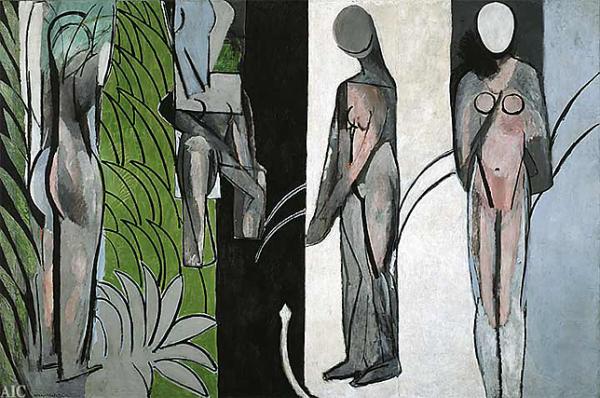Henri Matisse Gallery
Oil on canvas
259.7 x 389.9 cm
Charles H. and Mary F. S. Worcester Collection, 1953.158
During his long career, Henri Matisse worked in varied media, including painting, sculpture, printmaking, and collage. Matisse's art diverged from the Cubist style in his freer use of color and greater attention to the decorative effects of line and pattern. A leader of Fauvism, a movement that relied on the exaggerated, non-naturalistic use of color, Matisse later began to exhibit a more austere style closer to Cubism. Bathers by the River, a work completed in several stages between 1909 and 1916, is a supreme example of this phase in Matisse's art. It is considered one of his greatest masterpieces.
The painting began as one of three panels commissioned for the residence of a Moscow collector. The first version was a stylized rendering of a pastoral scene showing five nude females near a waterfall. After the collector decided not to purchase that composition, Matisse worked on the canvas again in 1913, eliminating one figure and transforming the remaining nudes into abstract forms.
Still dissatisfied with the painting in 1916, Matisse turned the blue stream into a black band, to which he added a white snake (possibly a reference to the snake that tempted Eve in paradise). He isolated the columnar figures against vertical zones of green, black, white, and grayish blue. Silhouetted against the light and dark zones at right, these somber figures are far removed from the graceful inhabitants of the original composition. In fact, the panel’s grave tone may reflect Matisse’s reaction to World War I (1914-1918) and the threat it posed to the values of art and life that the artist had originally set out to celebrate.

viewer |
|
|
Bathers by a River |
| Italian Woman |
| Dance |
| Promenade among the Olives |
| Butterfly Net |
| Carmelina |
| Abduction of Europa |
| Seance du Matin |
Biography
Bulletin Board
Renowned Art
(home)
Matisse was the leader of the Fauvist (meaning Wild Beasts) Movement, a painting style which focused on pure colors used in an aggressive and direct manner. His style changed many times over the years, but he never gave up his art. Matisse continued creating even into his 80's, when cancer had taken over his body. This was the time when he created the papercuttings that he is perhaps best known for. Matisse understood perfectly the relationship between color and shape, a talent which rightfully earned him the name "Master of Color."
all artists, with thumbnails: by birth year | alphabetically
all artists: by birth year | alphabetically
artists born in the 13th 14th 15th 16th 17th 18th 19th 20th century